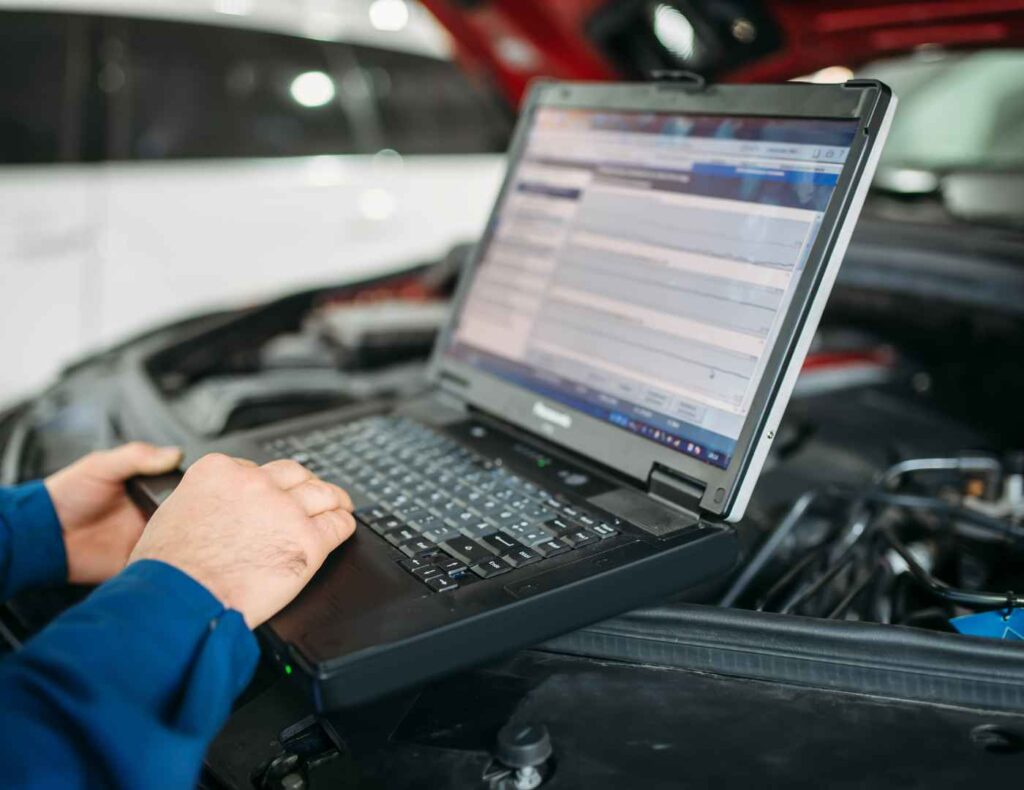How a Car Diagnostic Test Can Save You Thousands
When it comes to maintaining your vehicle, one of the most crucial steps is understanding how well it’s running. Many car owners may overlook or underestimate the importance of a car diagnostic test, but this simple yet vital process can save you thousands of dollars in the long run.
Car diagnostic tests are designed to help identify potential issues before they escalate into expensive repairs. Whether you’re dealing with a check engine light or noticing some unusual sounds or behaviors from your car, a diagnostic test could be the first step toward avoiding costly breakdowns.
In this blog post, we’ll dive deep into what a car diagnostic test is, why it’s so important, how much it costs, and how it can ultimately save you from expensive car repairs.

What Is a Car Diagnostic Test?
A car diagnostic test is a procedure that auto mechanics use to identify problems with your vehicle’s engine, transmission, exhaust system, and other critical components. The process involves using specialized equipment, often referred to as a diagnostic scanner or OBD2 scanner, which reads the codes generated by your vehicle’s onboard computer system.
Modern vehicles are equipped with an On-Board Diagnostics (OBD-II) system that monitors the performance of various systems and components. When something goes wrong, the system logs a code, which can be read through the diagnostic tool. These codes tell the mechanic what area of the car needs attention.
It’s a simple, non-invasive procedure that can save you a lot of time and money in repairs.
Why Is a Car Diagnostic Test Important?
A car diagnostic test is essential for several reasons, and here are a few of the most important ones:
1. Early Detection of Problems
When you use a diagnostic tool, you’re catching problems before they turn into expensive repairs. Many car issues, like failing sensors or worn-out spark plugs, can be detected early through a simple diagnostic scan. By fixing these issues early, you prevent them from escalating into bigger, more expensive problems that might require complete system overhauls.
2. Prevents Costly Repairs
A diagnostic test can pinpoint issues with your car before they result in major damage. For example, a failing fuel injector could go unnoticed for a long time if you don’t use a diagnostic test, which could eventually cause the engine to misfire or even seize. If caught early, replacing the injector is much cheaper than fixing a major engine issue caused by the malfunction.
3. Helps You Avoid Unnecessary Repairs
Sometimes, mechanics may suggest repairs for problems that don’t exist, simply because they can’t accurately diagnose the issue. With a diagnostic test, you’ll have a clear picture of what’s really wrong with your car. This transparency can help prevent unnecessary repairs, saving you money in the long run.
4. Keeps Your Car Running Efficiently
Routine car diagnostics help ensure that your vehicle is performing at its best. Over time, components like the oxygen sensors, mass airflow sensor, and catalytic converter can degrade, causing your car to lose fuel efficiency. A diagnostic test will alert you to these issues, helping you maintain good gas mileage and reduce fuel costs.
How Does a Car Diagnostic Test Work?
Understanding how a car diagnostic test works can help you appreciate its value. Here’s a step-by-step guide:
1. Plugging into the OBD-II Port
The process begins when the mechanic or technician connects the diagnostic scanner to your car’s OBD-II (On-Board Diagnostics) port. This port is usually located beneath the dashboard, near the driver’s side.
2. Reading Error Codes
Once connected, the diagnostic tool scans your car’s computer system for error codes. These codes provide insights into what’s going wrong with various car components. For example, a code might indicate that the oxygen sensor is malfunctioning or that there’s an issue with the engine misfire.
3. Interpreting the Codes
After reading the codes, the mechanic will interpret them using specialized software. Each code corresponds to a specific part or system in your vehicle. Some codes may indicate minor problems, while others may point to serious issues. Depending on the codes, the mechanic can recommend specific repairs.
4. Fixing the Issue
Once the problem is identified, the mechanic can proceed with repairs. For example, if the diagnostic test reveals an issue with your fuel system, the mechanic can replace the faulty fuel injector or clean the fuel lines.
5. Clearing the Codes
After the repairs are made, the mechanic will run another diagnostic scan to ensure the problem has been resolved. Once everything is fixed, the diagnostic codes are cleared from the system, and the vehicle should run like new.
Common Issues Detected by Car Diagnostic Tests
A car diagnostic test can identify a wide range of issues, from minor problems to more significant mechanical failures. Here are a few common issues that diagnostic tests can detect:
1. Check Engine Light (CEL)
One of the most common reasons people get a diagnostic test is because the check engine light has come on. This light can be triggered by a variety of issues, including:
Oxygen sensor failure
Loose or damaged gas cap
Faulty spark plugs
Faulty catalytic converter
Mass airflow sensor malfunction
2. Battery and Charging System Issues
A diagnostic test can reveal problems with your vehicle’s battery or alternator, which could prevent your car from starting or cause it to stall while driving.
3. Transmission Problems
A diagnostic test can help identify transmission issues, such as slipping gears, overheating, or failing solenoids. These issues, if caught early, are typically cheaper to fix before they cause significant damage to the transmission.
4. Engine Performance Issues
Problems with the fuel injectors, ignition system, or air-fuel ratio can all be diagnosed through a car diagnostic test. If your car is misfiring, stalling, or consuming too much fuel, a diagnostic test can pinpoint the cause.
5. Exhaust System Problems
The diagnostic tool can also help identify issues with the exhaust system, such as a failing oxygen sensor or a clogged catalytic converter, both of which can reduce your car’s efficiency and harm the environment.
How Much Does a Car Diagnostic Test Cost?
The cost of a car diagnostic test can vary widely depending on where you go and the type of test needed. In general, you can expect to pay for a diagnostic scan at most auto repair shops. Factors such as location, vehicle type, and the nature of the issue may influence the final cost.
Many shops offer free or discounted diagnostic tests if you decide to proceed with repairs at their location. This can be a great way to save money on the initial diagnostic fee.
Can a Car Diagnostic Test Save You Thousands?
Now that you know how a car diagnostic test works and why it’s essential, let’s answer the burning question: Can a car diagnostic test really save you thousands of dollars?
Yes, it absolutely can.
By detecting issues early on, you prevent them from turning into major, expensive problems. Here are some examples of how a diagnostic test can save you money:
1. Early Detection of a Failing Engine Part
Let’s say your oxygen sensor is failing, but you’re not experiencing noticeable symptoms. Without a diagnostic test, the sensor’s failure could go unnoticed, potentially damaging your catalytic converter. Replacing a catalytic converter can be quite costly, but by catching the issue early through a diagnostic test, you’ll save yourself from spending a large amount on a more extensive repair.
2. Avoiding Major Transmission Overhaul
A transmission failure can cost a significant amount to repair, especially if the issue is caught too late. If you use a diagnostic test to detect issues like slipping gears or low fluid, you can address the problem before it causes significant damage. Timely detection can help you avoid a complete transmission replacement.
3. Preventing Unnecessary Repairs
Without a diagnostic test, you might be tempted to fix a problem that doesn’t even exist. For instance, if your car is stalling, a mechanic might suggest replacing the fuel pump, but a diagnostic test could reveal the real issue is a worn-out spark plug. This simple fix could save you hundreds of dollars.
Conclusion
A car diagnostic test is a small investment that can save you thousands of dollars in repairs. By identifying issues early, preventing unnecessary repairs, and keeping your vehicle running efficiently, this simple process ensures that you spend less money on major car problems down the road. Whether it’s a minor issue like a faulty sensor or a more serious problem like a failing transmission, catching the issue early can save you from financial stress.
Next time your check engine light comes on or you experience any performance issues with your vehicle, don’t wait—schedule a car diagnostic test. It’s one of the smartest decisions you can make to protect your car and your wallet.

